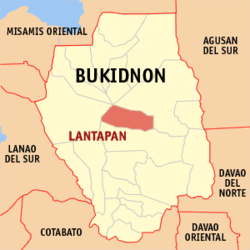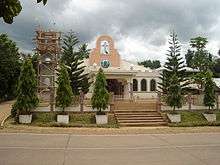Lantapan, Bukidnon
| Lantapan | |
|---|---|
| Municipality | |
|
Municipal/Town Hall | |
| Nickname(s): Heart of Bukidnon | |
 Map of Philippines with Lantapan highlighted | |
.svg.png) Lantapan Location within the Philippines | |
| Coordinates: 8°03′N 124°59′E / 8.05°N 124.98°ECoordinates: 8°03′N 124°59′E / 8.05°N 124.98°E | |
| Country | Philippines |
| Region | Northern Mindanao (Region X) |
| Province | Bukidnon |
| District | 2nd district of Bukidnon |
| Founded | June 18, 1968 |
| Barangays | 14 |
| Government[1] | |
| • Mayor | Ernie Devibar |
| Area[2] | |
| • Total | 328.35 km2 (126.78 sq mi) |
| Population (2015 census)[3] | |
| • Total | 61,776 |
| • Density | 190/km2 (490/sq mi) |
| Time zone | PST (UTC+8) |
| ZIP code | 8722 |
| IDD : area code | +63 (0)88 |
| Income class | 1st |
| Website |
www |
Lantapan is a first class municipality in the province of Bukidnon, Philippines. According to the 2015 census, it has a population of 61,776 people.[3] Lantapan is known as the “vegetable basket” of Mindanao.
It used to be a barrio of Malaybalay City until its creation, by virtue of Republic Act No. 4787 enacted on 18 June 1968, as a separate municipality.
Geography
The town is on a plateau in the heart of Bukidnon, situated between the Kalatungan and Kitanglad Mountain Ranges, after which its native name of "lantapan" was derived which means "level-on-top".
Lantapan is bounded on the north by the municipalities of Sumilao and Impasugong; east by Malaybalay City; south by Valencia City; and west by Talakag. It lies above sea level at an average of 600 metres (2,000 ft) and a maximum of 2,938 metres (9,639 ft) of the Kitanglad range.
It has an aggregate area of 318.2 km², mostly agriculture and forest lands. It has six river channels and 40 creeks and springs traversing across different points in the landscape. Lantapan is strategically located between two cities of Bukidnon, Malaybalay and Valencia. It can be reached via Aglayan crossing, which is a potential convergent zone of four cities: Iligan, Butuan, Davao and Cagayan de Oro.
Climate
The climatic condition of Lantapan is relatively cool and humid with winds blowing northward direction. November to April is relatively dry and May brings the start of the rains which continue 'til October. Mountains of neighboring towns in the north protect it from cyclone storms.
Barangays
Lantapan is politically subdivided into 14 barangays and 68 sitios.[2] The central district of the Poblacion is almost midway between the north and south sections of the municipality.
- Alanib
- Baclayon
- Balila
- Bantuanon
- Basak
- Bugcaon
- Kaatuan
- Capitan Juan
- Cawayan
- Kulasihan
- Kibangay
- Poblacion
- Songco
- Victory
Flora and fauna
Lantapan’s virgin forests are home to a diverse variety of flora and fauna. There are orchids, berries, pitcher plants, lichens, and a host of other wild flowers. A number of mammal species also thrive in the dense forests, including squirrels, monkeys, bats, flying lemurs, deer, tarsiers and wild pigs among others. The Philippine eagle (Pithecophaga jefferyi) along with other bird species such as the serpent eagle and sparrow hawk takes its home within the Mt. Kitanglad Range.
Demographics

| Population census of Lantapan | ||
|---|---|---|
| Year | Pop. | ±% p.a. |
| 1990 | 33,581 | — |
| 1995 | 36,943 | +1.80% |
| 2000 | 42,383 | +2.99% |
| 2007 | 51,406 | +2.70% |
| 2010 | 55,934 | +3.12% |
| 2015 | 61,776 | +1.91% |
| Source: Philippine Statistics Authority[3][4] | ||
In the 2015 census, the population of Lantapan was 61,776 people,[3] with a density of 190 inhabitants per square kilometre or 490 inhabitants per square mile.
Originally, the Talaandig were the main inhabitants of Lantapan. Then, migrants from the Visayas and northern Luzon started to settle in the area, even during the Spanish colonial period. More inflow took place after the Second World War. This stream of settlers eventually led to the varied mix of ethnic groups in Lantapan. Visayan is the predominant language, followed by Binukid. 2010 Census showed Lantapan's population have reached 55,934 with the Poblacion as the most populated barangay. Its population growth rate between 1980-1990 of 4.18% was well above the national rate of 2.3 percent.
The Tala’andig (one of the 7 tribes of Bukidnon) Ancestral Territory is native to Barangay Songco, where the tribal ways and customary law is tried to be revived and preserved. A school for living tradition was built as an avenue for elders to teach the young the traditional Tala’andig way of life, including its history, rituals, music, arts, embroidery, dance, and literature. Other activities involved earth paintings (painting utilizing soil as a medium), singing and dancing to traditional music, and making musical instruments and indigenous accessories among others.
Economy
Agriculture
Lantapan has agri-based economy. Farming has remained a dominant economic activity among the Lantapanons. The major crops grown are corn, coffee, cabbage and potatoes, sugarcane and other high valued crops and bananas also becoming an important commercial crop.
Lantapan is also home to two banana plantations: the Mount Kitanglad Agri-Ventures Inc. (MKAVI) and the Dole Banana Plantation with thousands of hectares of lands in the highland-barangays of the town planted with export quality bananas. The plantations started their operation in 1998 with thousand of residents of the municipality employed.
Commerce
There are 428 commercial establishments registered at the Licensing Division of the municipality, 15 of which are classified under agro-industrial, manufacturing and servicing. Trading activities include wholesale buying of corn, coffee and vegetables by traders from within Lantapan, neighboring towns in Bukidnon and Cagayan de Oro City.
Finance
For finance, the informal credit or "suki" system prevails. In this arrangement, the trader is usually the "suki" who provides credit too and buys the products of the farmer. A few cooperatives in some barangays also extend small loans to their members. An Asian Hills Bank located at the Poblacion and established in 1978, is owned by a private corporation. Its portfolio includes agricultural, commercial and real estate loans.
Attractions
- Kitanglad Mountain Range
- The Kitanglad Mountain Range is a very significant landmark in the cultural history of the indigenous peoples of Bukidnon with Mount Dulang-dulang considered as a sacred place. Being an ancestral domain, permission to enter must be secured from the tribal leaders of the Tala’andig tribe of Lantapan in deference to the Free Prior and Informed Consent (FPIC) mandated under the IPRA Law.
- The long trek to Mount Dulang-dulang’s summit goes through virgin dense forests, home to old trees covered with moss and lichens. At the highest peak, there is a panoramic view of the entire Kitanglad range, and on clear days, the distant Mount Apo. Sitio Bol-ogan in Barangay Songco of Lantapan is the shortest route towards the major start point to the peaks of Mount Kitanglad (with an elevation of 2,938 metres (9,639 ft) above sea level) and Mount Dulang-dulang (with an elevation of 2,987 metres (9,800 ft) above sea level) which is the country’s second-highest mountain, next to Mount Apo.at 3,144 metres (10,315 ft) above sea level
- Cinchona Forest Reserve
- The Cinchona Forest Reserve was established through a presidential proclamation in 1936, and now forms part of the protected area of the Mount Kitanglad Range Natural Park. It is home to the Cinchona Plantation, established at Barangay Kaatuan in 1929, and said to be the only of its kind left in Asia and the Pacific where the medicinal plant Cinchona (Cinchona ledgeriana) is grown. Cinchona, is a medium-sized tropical tree that can grow up 24 metres (79 ft) with a 60 centimetres (24 in) diameter, is a source of quinine that is used for malaria treatment. The farm covers an area of 1,725 hectares (4,260 acres) where 7 Cinchona tree species are found and is planted mostly with Albizza falcataria (= Falcataria moluccana) and other medicinal trees. Located 1,140 metres (3,740 ft) above sea level, the area is considered as the coldest place in Bukidnon with temperatures ranging from 13 to 18 °C (55 to 64 °F).
- Binahon Agro-forestry Farm
- The Binahon Agro-forestry Farm, located at Sitio Bol-ogan, Barangay Songco, on the slopes of Mt. Kitanglad, is a learning institution for farmers, agriculturists, and rural development workers. Situated some 1,300 metres (4,300 ft) above sea level, it cultivates various forest species such as Caribbean pine trees, lawaan, falcata, abaca, and eucalyptus. Fruit trees are also planted in the area with vegetables sown in between. Farm animals such as carabaos, horse, goats, sheep, hogs and other livestock animals are grown in the farm together with honeybees and tilapia. The farm also offers facilities for lodging to visiting tourists, researchers, scientists and mountaineers.
Barangay Kaatuan is also home to 8 conjoint water falls: 7 water falls pouring its contents onto another water falls. This conjoint waterfall is supplied by the Kulasihan River, and situated five kilometers from the barangay proper of Kaatuan called Block 2.
Infrastructure
Health services
The rural health unit (RHU) maintains one central health unit and 14 barangay health stations. The RHU provides medical, dental, family planning and laboratory services. Recently, it has started to provide special care and rehabilitation to malnourished children. One privately owned clinic for urgent care on minor cases and two registered mini-pharmaceutical stores are found in the Poblacion.
Water
Potable water is distributed through individual installations of 3,958 households. A feasibility study is being developed for the establishments of an improved and modern water system for Lantapan which entails tapping the Kulasihan and Songco water sources for an estimated flow of 45,018.168 cubic meter per hour.
Security
Lantapan is generally peaceful. Security in the area is ably maintained by the local police force. Trained civilian forces, the "Bantay-Bayan" and the Civilian Volunteer Organization (CVO) in the barangays also provide support to crime prevention.
Education
Presently, there is a total of 24 primary, elementary and secondary schools in Lantapan. These schools serve approximately 7,000 children. Day care centers under the Department of Social Welfare and Development provide preparatory education to pre-schoolers in the barangays.
References
- ↑ "Official City/Municipal 2013 Election Results". Intramuros, Manila, Philippines: Commission on Elections (COMELEC). 1 July 2013. Retrieved 5 September 2013.
- 1 2 "Province: BUKIDNON". PSGC Interactive. Makati City, Philippines: National Statistical Coordination Board. Retrieved 12 June 2014.
- 1 2 3 4 "Region X (NORTHERN MINDANAO)". Census of Population (2015): Total Population by Province, City, Municipality and Barangay (Report). PSA. Retrieved 20 June 2016.
- ↑ "Region X (NORTHERN MINDANAO)". Census of Population and Housing (2010): Total Population by Province, City, Municipality and Barangay (Report). NSO. Retrieved 29 June 2016.
External links
| Wikimedia Commons has media related to Lantapan, Bukidnon. |
 |
Mount Kitanglad | Malaybalay |  | |
| Talakag | |
Malaybalay | ||
| ||||
| | ||||
| Valencia |